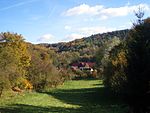Nordhausen (pronounced [ˈnɔʁtˌhaʊ̯zn̩] ) is a city in Thuringia, Germany. It is the capital of the Nordhausen district and the urban centre of northern Thuringia and the southern Harz region; its population is 42,000. Nordhausen is located approximately 60 km (37 miles) north of Erfurt, 80 km (50 miles) west of Halle, 85 km (53 miles) south of Braunschweig and 60 km (37 miles) east of Göttingen.
Nordhausen was first mentioned in records in the year 927 and became one of the most important cities in central Germany during the later Middle Ages. The city is situated on the Zorge river, a tributary of the Helme within the fertile region of Goldene Aue (golden floodplain) at the southern edge of the Harz mountains. In the early 13th century, it became a free imperial city, so that it was an independent and republican self-ruled member of the Holy Roman Empire. Due to its long-distance trade, Nordhausen was prosperous and influential, with a population of 8,000 around 1500. It was the third-largest city in Thuringia after Erfurt, today's capital, and Mühlhausen, the other free imperial city in the land.
Nordhausen was once known for its tobacco industry and is still known for its distilled spirit, Nordhäuser Doppelkorn. Industrialization accompanied railway construction that linked the cities to major markets in the mid-19th century. In the late 19th century, narrow-gauge railways were constructed in this region through the Harz mountains. In December 1898 the Nordhausen-Wernigerode Railway Company (Nordhausen-Wernigeroder Eisenbahn-Gesellschaft) or NWE added a line, with the full network operating by 1899. The Harz Narrow Gauge Railways are maintained today by local authorities and frequented primarily by tourists.
In the early 20th century, this became a centre of the engineering and arms industries. During World War II, the Nazi German government established and operated the nearby KZ Mittelbau-Dora concentration camp, where 60,000 forced labourers had to work in the arms industry. They were prisoners of war and persons from occupied territories. Some 20,000 persons died because of the bad conditions. In April 1945, most of the city was destroyed by Royal Air Force bombings, resulting in 8,800 casualties (more than 20% of the population). Most of the historic buildings in the city were destroyed; it suffered the most damage during the war of any city in Thuringia. A week later the United States troops occupied the city, followed weeks later by the Soviet Red Army. The city was within the Soviet zone of occupation, and later the territory was known as East Germany. Hundreds of German scientists and their families from Nordhausen were among thousands deported to the Soviet Union after the war to work on advanced rocket and other arms engineering projects.
Nordhausen is the birthplace of the mathematician Oswald Teichmüller, known for his groundbreaking work on the Teichmüller spaces – which were named after him. It is the site of the Nordhausen University of Applied Sciences (Fachhochschule Nordhausen), founded in 1997 after the reunification of Germany. The university has 2,500 students.





